2007 CHEVROLET AVEO brake light
[x] Cancel search: brake lightPage 236 of 436
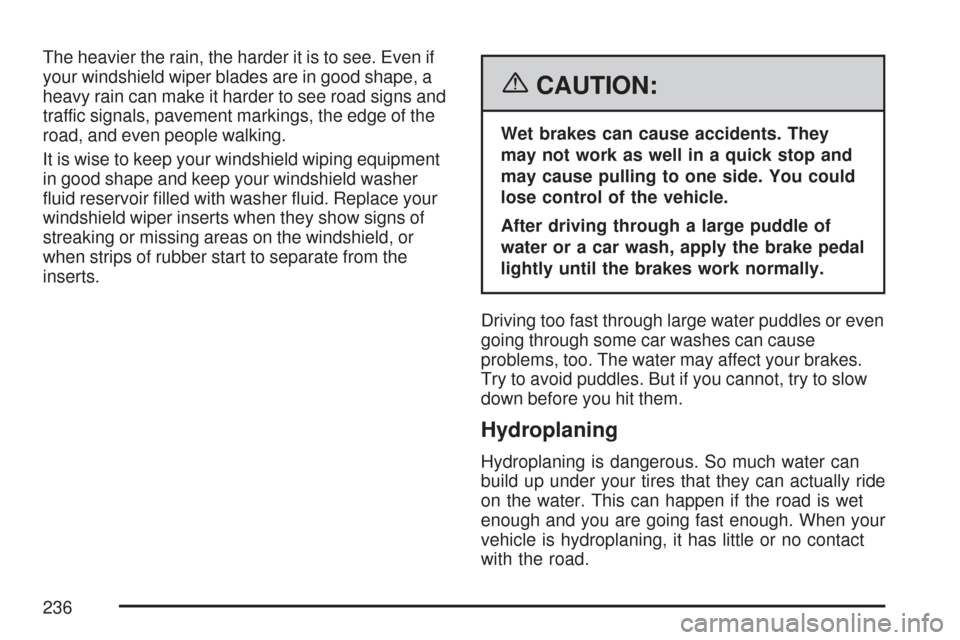
The heavier the rain, the harder it is to see. Even if
your windshield wiper blades are in good shape, a
heavy rain can make it harder to see road signs and
traffic signals, pavement markings, the edge of the
road, and even people walking.
It is wise to keep your windshield wiping equipment
in good shape and keep your windshield washer
fluid reservoir filled with washer fluid. Replace your
windshield wiper inserts when they show signs of
streaking or missing areas on the windshield, or
when strips of rubber start to separate from the
inserts.
{CAUTION:
Wet brakes can cause accidents. They
may not work as well in a quick stop and
may cause pulling to one side. You could
lose control of the vehicle.
After driving through a large puddle of
water or a car wash, apply the brake pedal
lightly until the brakes work normally.
Driving too fast through large water puddles or even
going through some car washes can cause
problems, too. The water may affect your brakes.
Try to avoid puddles. But if you cannot, try to slow
down before you hit them.
Hydroplaning
Hydroplaning is dangerous. So much water can
build up under your tires that they can actually ride
on the water. This can happen if the road is wet
enough and you are going fast enough. When your
vehicle is hydroplaning, it has little or no contact
with the road.
236
Page 277 of 436
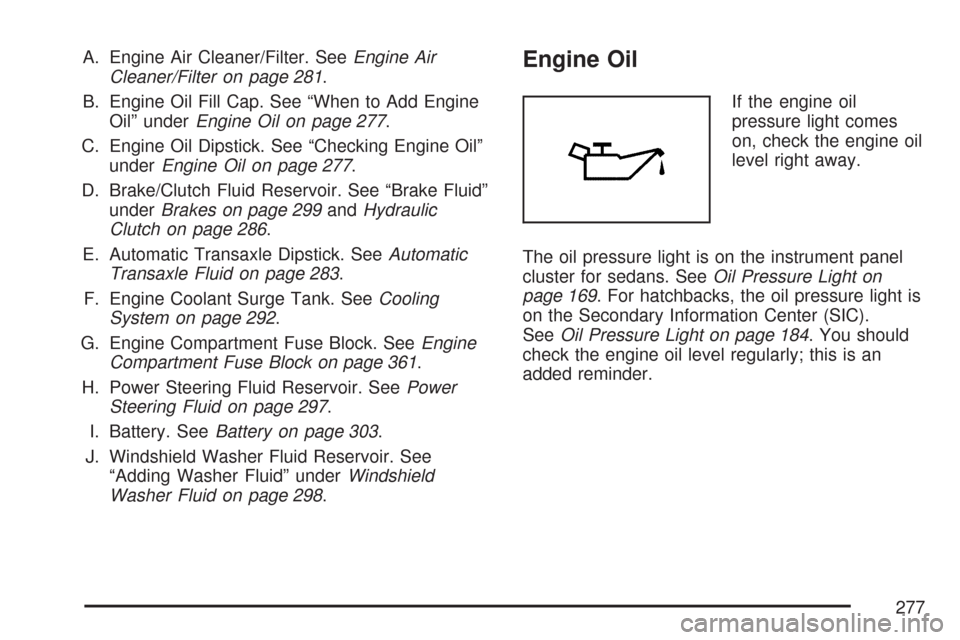
A. Engine Air Cleaner/Filter. SeeEngine Air
Cleaner/Filter on page 281.
B. Engine Oil Fill Cap. See “When to Add Engine
Oil” underEngine Oil on page 277.
C. Engine Oil Dipstick. See “Checking Engine Oil”
underEngine Oil on page 277.
D. Brake/Clutch Fluid Reservoir. See “Brake Fluid”
underBrakes on page 299andHydraulic
Clutch on page 286.
E. Automatic Transaxle Dipstick. SeeAutomatic
Transaxle Fluid on page 283.
F. Engine Coolant Surge Tank. SeeCooling
System on page 292.
G. Engine Compartment Fuse Block. SeeEngine
Compartment Fuse Block on page 361.
H. Power Steering Fluid Reservoir. SeePower
Steering Fluid on page 297.
I. Battery. SeeBattery on page 303.
J. Windshield Washer Fluid Reservoir. See
“Adding Washer Fluid” underWindshield
Washer Fluid on page 298.Engine Oil
If the engine oil
pressure light comes
on, check the engine oil
level right away.
The oil pressure light is on the instrument panel
cluster for sedans. SeeOil Pressure Light on
page 169. For hatchbacks, the oil pressure light is
on the Secondary Information Center (SIC).
SeeOil Pressure Light on page 184. You should
check the engine oil level regularly; this is an
added reminder.
277
Page 300 of 436
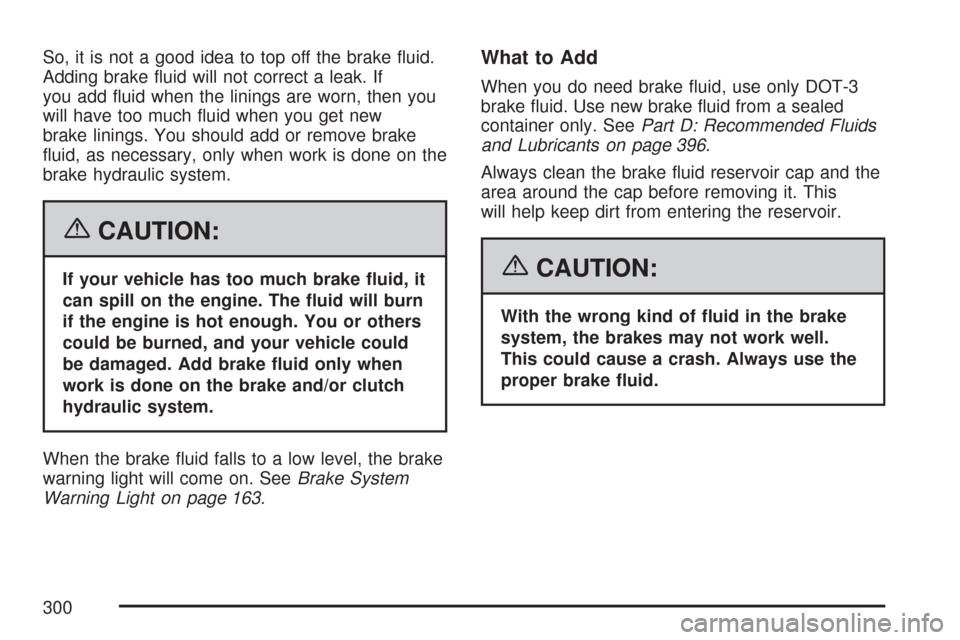
So, it is not a good idea to top off the brake fluid.
Adding brake fluid will not correct a leak. If
you add fluid when the linings are worn, then you
will have too much fluid when you get new
brake linings. You should add or remove brake
fluid, as necessary, only when work is done on the
brake hydraulic system.
{CAUTION:
If your vehicle has too much brake �uid, it
can spill on the engine. The �uid will burn
if the engine is hot enough. You or others
could be burned, and your vehicle could
be damaged. Add brake �uid only when
work is done on the brake and/or clutch
hydraulic system.
When the brake fluid falls to a low level, the brake
warning light will come on. SeeBrake System
Warning Light on page 163.
What to Add
When you do need brake fluid, use only DOT-3
brake fluid. Use new brake fluid from a sealed
container only. SeePart D: Recommended Fluids
and Lubricants on page 396.
Always clean the brake fluid reservoir cap and the
area around the cap before removing it. This
will help keep dirt from entering the reservoir.
{CAUTION:
With the wrong kind of �uid in the brake
system, the brakes may not work well.
This could cause a crash. Always use the
proper brake �uid.
300
Page 301 of 436
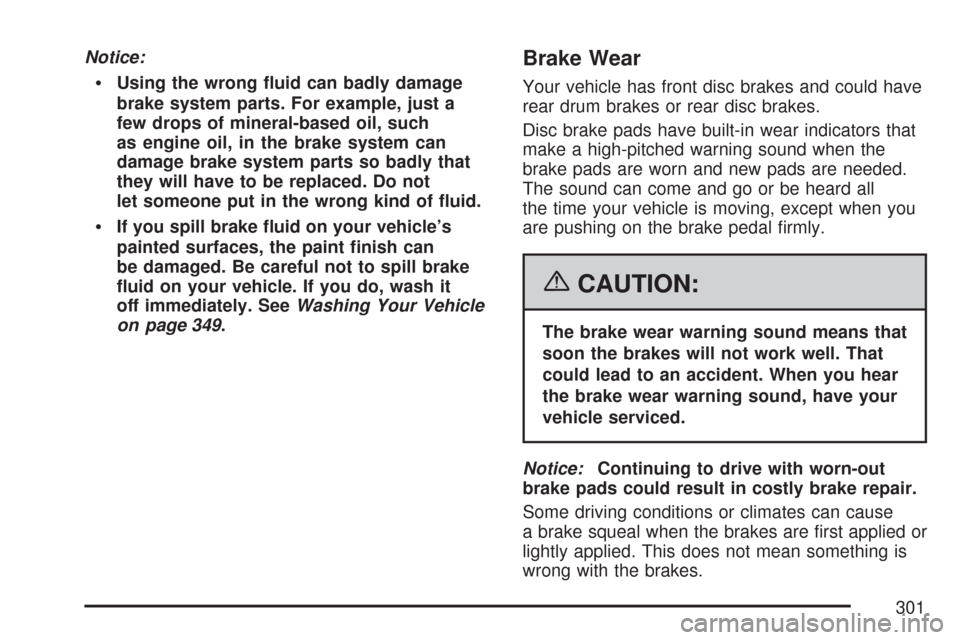
Notice:
Using the wrong �uid can badly damage
brake system parts. For example, just a
few drops of mineral-based oil, such
as engine oil, in the brake system can
damage brake system parts so badly that
they will have to be replaced. Do not
let someone put in the wrong kind of �uid.
If you spill brake �uid on your vehicle’s
painted surfaces, the paint �nish can
be damaged. Be careful not to spill brake
�uid on your vehicle. If you do, wash it
off immediately. SeeWashing Your Vehicle
on page 349.
Brake Wear
Your vehicle has front disc brakes and could have
rear drum brakes or rear disc brakes.
Disc brake pads have built-in wear indicators that
make a high-pitched warning sound when the
brake pads are worn and new pads are needed.
The sound can come and go or be heard all
the time your vehicle is moving, except when you
are pushing on the brake pedal firmly.
{CAUTION:
The brake wear warning sound means that
soon the brakes will not work well. That
could lead to an accident. When you hear
the brake wear warning sound, have your
vehicle serviced.
Notice:Continuing to drive with worn-out
brake pads could result in costly brake repair.
Some driving conditions or climates can cause
a brake squeal when the brakes are first applied or
lightly applied. This does not mean something is
wrong with the brakes.
301
Page 305 of 436
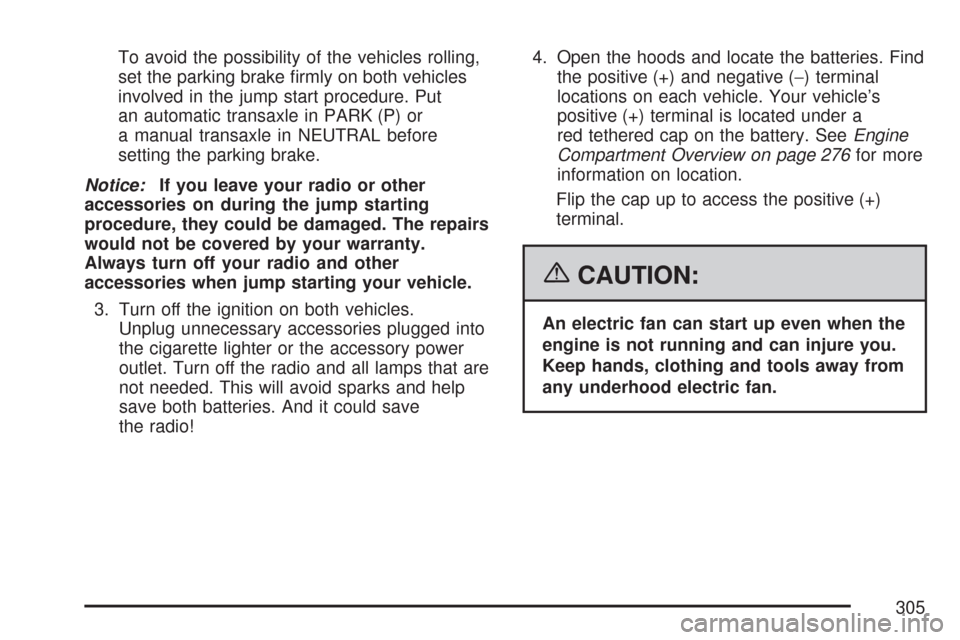
To avoid the possibility of the vehicles rolling,
set the parking brake firmly on both vehicles
involved in the jump start procedure. Put
an automatic transaxle in PARK (P) or
a manual transaxle in NEUTRAL before
setting the parking brake.
Notice:If you leave your radio or other
accessories on during the jump starting
procedure, they could be damaged. The repairs
would not be covered by your warranty.
Always turn off your radio and other
accessories when jump starting your vehicle.
3. Turn off the ignition on both vehicles.
Unplug unnecessary accessories plugged into
the cigarette lighter or the accessory power
outlet. Turn off the radio and all lamps that are
not needed. This will avoid sparks and help
save both batteries. And it could save
the radio!4. Open the hoods and locate the batteries. Find
the positive (+) and negative (−) terminal
locations on each vehicle. Your vehicle’s
positive (+) terminal is located under a
red tethered cap on the battery. SeeEngine
Compartment Overview on page 276for more
information on location.
Flip the cap up to access the positive (+)
terminal.
{CAUTION:
An electric fan can start up even when the
engine is not running and can injure you.
Keep hands, clothing and tools away from
any underhood electric fan.
305
Page 360 of 436
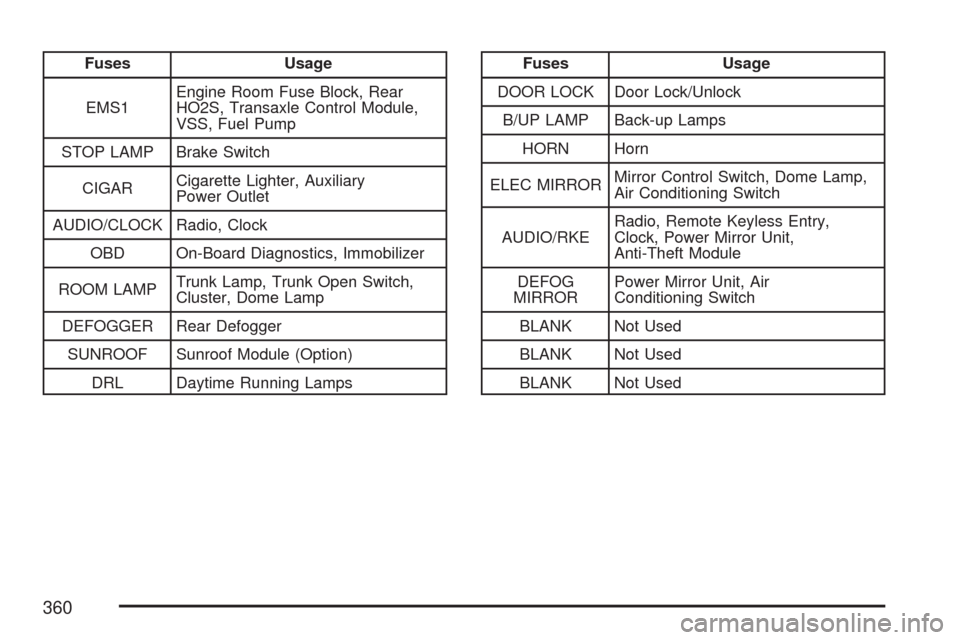
Fuses Usage
EMS1Engine Room Fuse Block, Rear
HO2S, Transaxle Control Module,
VSS, Fuel Pump
STOP LAMP Brake Switch
CIGARCigarette Lighter, Auxiliary
Power Outlet
AUDIO/CLOCK Radio, Clock
OBD On-Board Diagnostics, Immobilizer
ROOM LAMPTrunk Lamp, Trunk Open Switch,
Cluster, Dome Lamp
DEFOGGER Rear Defogger
SUNROOF Sunroof Module (Option)
DRL Daytime Running LampsFuses Usage
DOOR LOCK Door Lock/Unlock
B/UP LAMP Back-up Lamps
HORN Horn
ELEC MIRRORMirror Control Switch, Dome Lamp,
Air Conditioning Switch
AUDIO/RKERadio, Remote Keyless Entry,
Clock, Power Mirror Unit,
Anti-Theft Module
DEFOG
MIRRORPower Mirror Unit, Air
Conditioning Switch
BLANK Not Used
BLANK Not Used
BLANK Not Used
360
Page 423 of 436
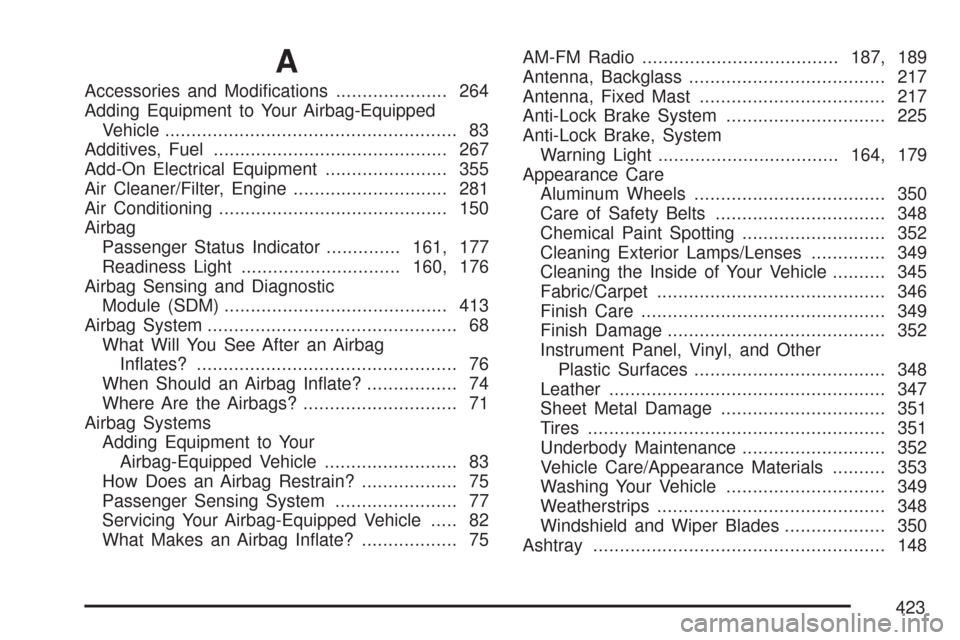
A
Accessories and Modifications..................... 264
Adding Equipment to Your Airbag-Equipped
Vehicle....................................................... 83
Additives, Fuel............................................ 267
Add-On Electrical Equipment....................... 355
Air Cleaner/Filter, Engine............................. 281
Air Conditioning........................................... 150
Airbag
Passenger Status Indicator..............161, 177
Readiness Light..............................160, 176
Airbag Sensing and Diagnostic
Module (SDM).......................................... 413
Airbag System............................................... 68
What Will You See After an Airbag
Inflates?................................................. 76
When Should an Airbag Inflate?................. 74
Where Are the Airbags?............................. 71
Airbag Systems
Adding Equipment to Your
Airbag-Equipped Vehicle......................... 83
How Does an Airbag Restrain?.................. 75
Passenger Sensing System....................... 77
Servicing Your Airbag-Equipped Vehicle..... 82
What Makes an Airbag Inflate?.................. 75AM-FM Radio.....................................187, 189
Antenna, Backglass..................................... 217
Antenna, Fixed Mast................................... 217
Anti-Lock Brake System.............................. 225
Anti-Lock Brake, System
Warning Light..................................164, 179
Appearance Care
Aluminum Wheels.................................... 350
Care of Safety Belts................................ 348
Chemical Paint Spotting........................... 352
Cleaning Exterior Lamps/Lenses.............. 349
Cleaning the Inside of Your Vehicle.......... 345
Fabric/Carpet........................................... 346
Finish Care.............................................. 349
Finish Damage......................................... 352
Instrument Panel, Vinyl, and Other
Plastic Surfaces.................................... 348
Leather.................................................... 347
Sheet Metal Damage............................... 351
Tires........................................................ 351
Underbody Maintenance........................... 352
Vehicle Care/Appearance Materials.......... 353
Washing Your Vehicle.............................. 349
Weatherstrips........................................... 348
Windshield and Wiper Blades................... 350
Ashtray....................................................... 148
423
Page 424 of 436
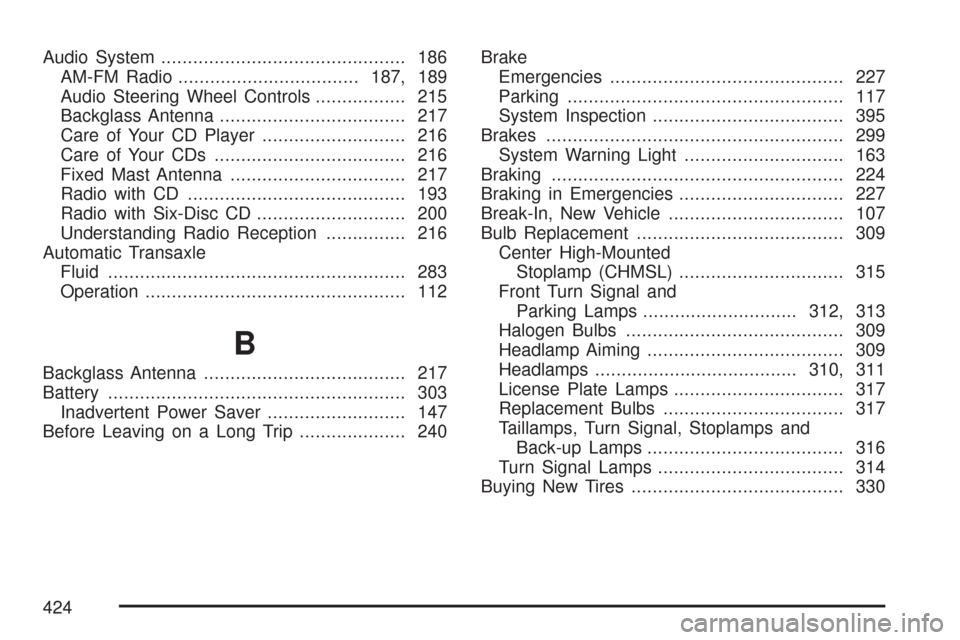
Audio System.............................................. 186
AM-FM Radio..................................187, 189
Audio Steering Wheel Controls................. 215
Backglass Antenna................................... 217
Care of Your CD Player........................... 216
Care of Your CDs.................................... 216
Fixed Mast Antenna................................. 217
Radio with CD......................................... 193
Radio with Six-Disc CD............................ 200
Understanding Radio Reception............... 216
Automatic Transaxle
Fluid........................................................ 283
Operation................................................. 112
B
Backglass Antenna...................................... 217
Battery........................................................ 303
Inadvertent Power Saver.......................... 147
Before Leaving on a Long Trip.................... 240Brake
Emergencies............................................ 227
Parking.................................................... 117
System Inspection.................................... 395
Brakes........................................................ 299
System Warning Light.............................. 163
Braking....................................................... 224
Braking in Emergencies............................... 227
Break-In, New Vehicle................................. 107
Bulb Replacement....................................... 309
Center High-Mounted
Stoplamp (CHMSL)............................... 315
Front Turn Signal and
Parking Lamps.............................312, 313
Halogen Bulbs......................................... 309
Headlamp Aiming..................................... 309
Headlamps......................................310, 311
License Plate Lamps................................ 317
Replacement Bulbs.................................. 317
Taillamps, Turn Signal, Stoplamps and
Back-up Lamps..................................... 316
Turn Signal Lamps................................... 314
Buying New Tires........................................ 330
424